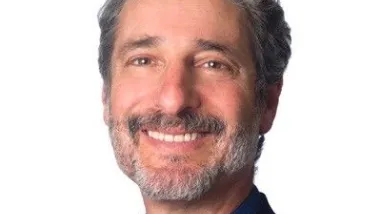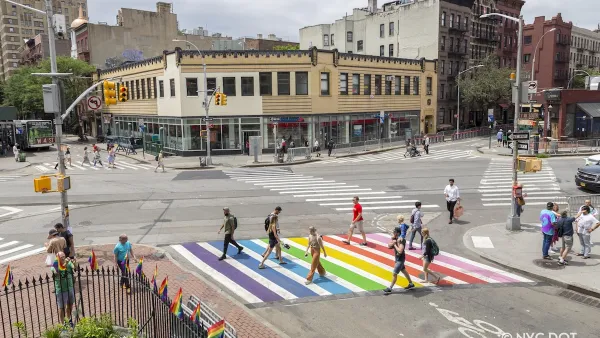To create more affordable, healthy, equitable, accessible, and resource-efficient communities, planners must reform the way we value speed relative to other community goals.

The majority of vehicles on the road are economy and luxury cars, SUVs, vans and light trucks, not sports cars. This demonstrates that motorists tend to value affordability, comfort, convenience, and safety more than speed. Transportation planning should reflect those priorities. However, in many, often subtle ways, conventional planning tends to overvalue speed and undervalue other goals, resulting in a less efficient and equitable transportation system than travelers prefer.
This is an important and timely issue. How a planning process values speed relative to other goals has huge impacts on community affordability, health, resource efficiency, and social equity. My new report, "Not So Fast: Better Speed Valuation for Transportation Planning," critically evaluates the assumptions and methods that planners use to value travel speed. Let me summarize the study's highlights.
Planning decisions often involve trade-offs between travel speeds and other impacts. For example:
- Transportation agencies can invest in faster modes, such as driving, or slower more affordable, healthy, inclusive and resource-efficient modes such as walking, bicycling and public transit.
- Roads can be designed for higher traffic speeds, with wider lanes, longer blocks and fewer crosswalks, or to maximize safety and accommodate more diverse users with lower design speeds, narrower lanes, shorter blocks, and more space devoted to sidewalks, bike- and bus lanes.
- Development policies can favor automobile-oriented sprawl, which requires more speed and mobility, or create more compact, multimodal neighborhoods where travel distances are shorter and speeds are lower.
Faster travel has both benefits and costs. It increases the destinations that people can access in a given time period, and therefore their economic and social opportunities, but also increases many costs to users and communities, as illustrated in the table below.
Typical Benefits and Cost of Faster Travel
Benefits |
Costs |
|
|
Higher speeds provide user benefits and increase various costs to users and communities.
Conventional planning considers some of these impacts but often overlooks or undervalues others, particularly long-term effects caused by changes in accessibility, total vehicle travel, and development patterns. The table below summarizes how conventional transportation planning evaluates each of these impacts.
Speed Impacts Considered in Conventional Planning
Impacts of Higher Speeds |
Consideration in Conventional Planning |
|
Increased motorist access |
Often described and sometimes quantified. |
|
Travel time savings |
Often quantified. Is generally the largest impact considered. |
|
Economic development and opportunity |
Often exaggerates the economic benefits and overlooks the costs of speed, and underestimates economic benefits provided by slower modes. |
|
Reduced traveler comfort and increased driver stress |
Generally ignored. Seldom considers the discomfort and stress of faster speeds. |
|
Increased vehicle costs |
Often quantify fuel cost savings from reduced congestion, but ignore the increased user costs of shifts from slower to faster modes, and from induced travel. |
|
Increased infrastructure costs |
Considers direct costs but ignores the additional road and parking facility costs from induced vehicle travel. |
|
Congestion and barrier effect |
Congestion is considered but barrier effects are generally ignored. |
|
Crash costs |
Considers how speed changes affect distance-based crash rates, but generally ignores the additional crashes caused by induced travel. |
|
Energy consumption and pollution emissions |
Considers how speed changes affect distance-based energy consumption and emission rates, but generally ignores the effects of induced vehicle travel. |
|
Community livability and cohesion |
Generally ignored. Seldom considers qualitative factors. |
|
Automobile dependency and sprawl |
Generally ignored. Integrated transportation and land use models can predict these impacts, but they are seldom used for individual project evaluations. |
|
Social equity |
There is little analysis of the fairness of investments in faster vs. slower modes. |
Conventional transportation evaluation describes and quantifies the direct user benefits of increased traffic speeds, but tends to overlook or undervalue many of the costs, particularly the indirect and long-term impacts of increased vehicle travel and sprawl.
A key conclusion of my study is that it is possible, and probably common, for planning decisions to increase speed in ways that are economically inefficient, that is, their total costs exceed their benefits. This is particularly evident if transportation system performance is evaluated based on accessibility, which strives to maximize access to services and activities, rather than using mobility-based indicators such as traffic speed and delay. Conventional planning often assumes that higher speeds provide time savings, but there is good evidence that over the long run people tend to maintain fixed travel time budgets, so higher speeds increase mobility (i.e., the distances that people travel) rather than saving time, and contribute to a self-reinforcing cycle of increased vehicle travel, automobile-dependency and sprawl, as illustrated below. This causes mobility inflation, which ratchets up the distances people must travel to meet their needs, which is costly to communities and unfair to people with limited mobility.
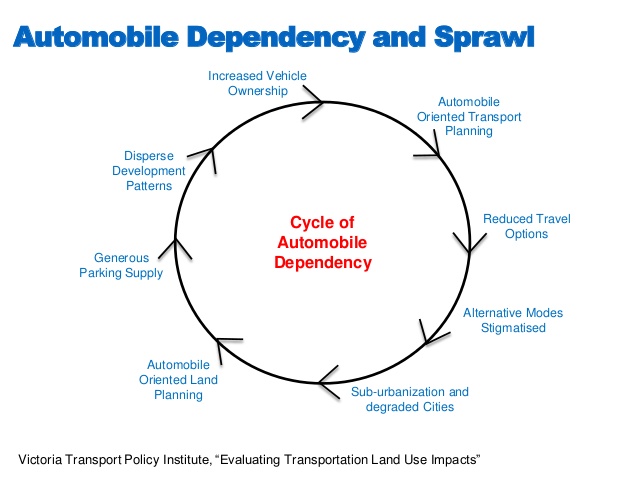
The inefficiency and inequity of speed-prioritizing planning are evident if transport performance is evaluated using effective speed, defined as travel distance divided by the time spent traveling and earning money to pay travel expenses. Measured this way, automobile travel is often slower overall than active and transit modes, and is regressive because it benefits affluent motorists who value time more than money, but harms people who have other priorities.
Minutes Per Mile for Various Travelers
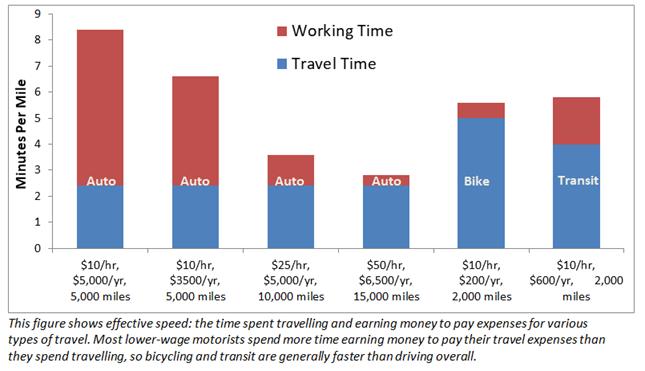
Conventional planning assumes that travelers prioritize speed, but in practice they often choose slower options for affordability, health, enjoyment and livability sake; for example, motorists choosing slower but more scenic routes, or commuters who bicycle for enjoyment or fitness sake, or take public transit because they can relax and work while travelling. Surveys indicate that many people want to drive less, rely more on slower modes, live in more compact communities, and reduce their transportation costs. To be efficient and equitable, planning must respond to these demands.
Speed optimization requires comprehensive analysis of impacts. Transportation engineers generally recognize the trade-offs between traffic speed and safety, but undervalue other effects. For example, commonly used transportation data sets undercount travel by slower modes; transport models are scaled to evaluate regional travel and overlook conditions within neighborhoods; economic analysis measures traffic speeds but not the convenience and comfort of slower modes; and many external impacts that increase with speed, such as the barrier effect, noise, and induced travel and sprawl costs, are generally overlooked.
The following factors should be considered when evaluating travel speed changes.
- Impacts on overall accessibility, considering all travel modes. For example, analysis should consider ways that wider roads and increased traffic may reduce access by non-auto modes.
- Travel time cost variations and therefore the benefits (travel time cost reductions) of improving travel comfort and convenience, particularly for active and public transport modes.
- Impacts on user costs and affordability. Faster modes tend to be costly; lower-speed modes are more affordable.
- External costs that increase with speed, including road and parking infrastructure costs, congestion, crash risk and pollution emissions. These should be recognized, and where possible quantified.
- Automobile dependency and sprawl. As much as possible, planning should describe, and if possible model, ways that higher speeds help create communities where it is difficult to get around without a car, and development is dispersed, and the costs that result.
- Social equity impacts including underinvestment in slower modes, harms that faster modes impose on slower modes, and impacts on disadvantaged groups. The table below indicates groups that benefit or are harmed by speed-prioritizing planning.
Speed-Prioritizing Equity Impacts
Who Benefits |
Who is Harmed |
|
· Wealthier suburban motorists · Automobile industries and suburban developers |
· People who need or prefer slower modes. · Motorists who spend more than they can afford on transport or have excessive chauffeuring burdens. · Urban residents harmed by traffic risk and pollution. · People harmed by environmental risks. |
Speed-prioritizing planning tends to benefit some people, but harms others.
Because slower modes are so constrained, small increases in their speed or access can provide relatively large benefits. For example, a 1,000 foot shortcut saves pedestrians about the same amount of travel time as a motorist gains from two-mile shortcut. The value that people place on travel time varies. Under uncomfortable conditions, time spent traveling can have high unit costs, so improving travel comfort is comparable to increasing speeds, particularly for walking, bicycling and public transit travel.
It can be useful to compare the allocation of resources between faster and slower modes. Policies that favor faster modes often result in an unfair portion of funding and road space being devoted to automobile facilities to the detriment of walking, bicycling and public transit. Similarly, crash risk and casualty rates can be compared between faster and slower modes
To their credit, many decision-makers support slower modes and traffic speed reductions more than justified by their analysis models; they realize intuitively that walking, bicycling and public transit are important and deserve significant investments. However, this occurs despite rather than supported by standard planning methods. Reforming these practices can justify much more support for slower modes. More comprehensive analysis of speed-related impacts is likely to reduce investments in urban highways, increase investments in slower modes, reduce roadway design speeds, reduce emphasis on mobility and increase emphasis on multimodal accessibility, and support improvements to travel comfort and convenience, than what results from current planning practices.
The amount that people travel, and therefore the transportation costs they bear and impose on their communities, varies widely depending on geography and personal lifestyle. Households in central city neighborhoods average less than 20 daily vehicle-miles, compared with more than 50 in automobile-dependent suburbs, as illustrated below. Their transportation costs, including their own vehicle expenses, the costs of road and parking facilities required for their travel, plus the congestion, crash and environmental costs they impose on other people, also vary by similar amounts.
Household Vehicle Travel and Expenses by Location
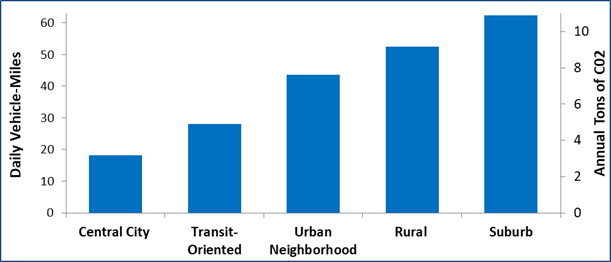
Residents of high-accessibility neighborhoods drive significantly less, rely more on slower modes, spend less money on transportation, and impose less external costs than in more automobile-dependent areas. (Image source: California Air Resources Board and the California Environmental Protection Agency)
I can report from personal experience that it is possible, and in many ways better, to rely on slower modes; our family has been car-free for more than a decade. This is feasible because we live in a high-accessibility neighborhood located within convenient walking and bicycling distances of numerous services. In fifteen minutes we can walk or bike to more stores, restaurants, parks and jobs than most suburban motorists can reach by car in the same time period, with far lower costs and greater enjoyment. Our transportation cost savings financed our children’s university educations and now leaves us with money to spend on luxuries that would be unaffordable if we lived an automobile-dependent lifestyle. Our daily walking and bicycling maintains our health without requiring special time or expenses for exercise, and nearly every day we have friendly conversations with neighbors.
We are lucky. Most households cannot live this lifestyle because there is a shortage of affordable housing in high-accessibility neighborhoods. During the last century, most were displaced by urban highways and parking lots, or degraded by heavy traffic that makes walking and bicycling dangerous and unpleasant. Why? Although there are many ways to answer this question, a key factor is the common assumption that faster travel is better than slower travel, even in compact urban communities. The shortage of high-accessibility neighborhoods is the result of a self-fulfilling prophecy, as faster traffic squeezes out slower but more affordable and efficient alternatives.
This can change. With more comprehensive analysis of speed impacts, communities can create more affordable, healthy and resource-efficient transportation options that benefit everybody by reducing external costs.
Of course, every traveller has unique needs and preferences. Many will choose faster modes, such as automobiles, despite their higher costs, for the sake of convenience or status. However, current demographic and economic trends—aging population, increasing urbanization, plus growing concerns about affordability, public health and environmental quality—are increasing demand for slower modes and livable neighborhoods. Given better options, many people would shift from driving to slower modes, and from automobile-dependent sprawled areas to more compact, multimodal communities. Everybody benefits if our planning practices respond to these demands.
For More Information
AARP and CNU (2021), Enabling Better Places: A Handbook for Improved Neighborhoods, American Association of Retired Persons and Congress for New Urbanism.
John Adams (1999), The Social Implications of Hypermobility, Organization for Economic Cooperation and Development
Asif Ahmed and Peter Stopher (2014), “Seventy Minutes Plus or Minus 10 — A Review of Travel Time Budget Studies,” Transport Reviews, Vo. 34:5, pp. 607-625 (DOI: 10.1080/01441647.2014.946460).
Michael Brenneis (2021), Speed Limit Standards are an Essential Step Toward Safer Streets, State Smart Transportation Initiative.
Joe Cortright (2017), Driving Faster Doesn’t Make You Happier: It Just Makes You Drive Farther, City Labs.
EEA (2020), Do Lower Speed Limits on Motorways Reduce Fuel Consumption and Pollutant Emissions?, European Energy Agency.
Jonathan English (2019), The Commuting Principle that Shaped Urban History, City Lab.
Susan Handy (2020), What California Gains from Reducing Car Dependence, National Center for Sustainable Transportation.
Jon Larson (2018), Forgiving Design Vs. the Forgiveness of Slow Speeds, Strong Towns.
Jonathan Levine, et al. (2012), “Does Accessibility Require Density or Speed?” Journal of the American Planning Asso, Vol. 78/2, pp. 157-172 (doi.org/10.1080/01944363.2012.677119).
David M. Levinson, Wes Marshall and Kay Axhausen (2018), Elements of Access: Transport Planning for Engineers, Transport Engineering for Planners, Transportist.
Todd Litman (2014), The Mobility-Productivity Paradox: Exploring The Negative Relationships Between Mobility and Economic Productivity, International Transportation Economic Development Conference.
Todd Litman (2020), Our World Accelerated: How 120 Years of Transportation Progress Affects Our Lives and Communities, Victoria Transport Policy Institute.
Todd Litman (2021), Not So Fast: Better Speed Valuation for Transportation Planning, Victoria Transport Policy Institute.
David Metz (2008), “The Myth of Travel Time Saving,” Transport Reviews, Vol. 28, No. 3, pp. 321- 336; at.
NACTO (2020), City Limits: Setting Safe Speed Limits on Urban Streets, National Association of City Transportation Officials.
OECD (2020), Reversing Automobile Dependency, International Transport Forum (www.itf-oecd.org); at.
Donald A. Redelmeier and Ahmed M. Bayoumi (2010), “Time Lost by Driving Fast in the United States,” Medical Decision Making, Vol. 30, No. 3, pp. E12-E19.
Christopher Standen (2018), The Value of Slow Travel: An Econometric Method for Valuing the User Benefits of Active Transport Infrastructure, PhD Thesis, University of Sydney.
Paul Joseph Tranter (2010), “Speed Kills: The Complex Links Between Transport, Lack of Time and Urban Health,” Journal of Urban Health, Vol. 87/2 (doi:10.1007/s11524-009-9433-9).

Planetizen Federal Action Tracker
A weekly monitor of how Trump’s orders and actions are impacting planners and planning in America.

Chicago’s Ghost Rails
Just beneath the surface of the modern city lie the remnants of its expansive early 20th-century streetcar system.

Amtrak Cutting Jobs, Funding to High-Speed Rail
The agency plans to cut 10 percent of its workforce and has confirmed it will not fund new high-speed rail projects.

Ohio Forces Data Centers to Prepay for Power
Utilities are calling on states to hold data center operators responsible for new energy demands to prevent leaving consumers on the hook for their bills.

MARTA CEO Steps Down Amid Citizenship Concerns
MARTA’s board announced Thursday that its chief, who is from Canada, is resigning due to questions about his immigration status.

Silicon Valley ‘Bike Superhighway’ Awarded $14M State Grant
A Caltrans grant brings the 10-mile Central Bikeway project connecting Santa Clara and East San Jose closer to fruition.
Urban Design for Planners 1: Software Tools
This six-course series explores essential urban design concepts using open source software and equips planners with the tools they need to participate fully in the urban design process.
Planning for Universal Design
Learn the tools for implementing Universal Design in planning regulations.
Caltrans
City of Fort Worth
Mpact (founded as Rail~Volution)
City of Camden Redevelopment Agency
City of Astoria
City of Portland
City of Laramie

























